Integrated campaigns are effective at balancing both short-term sales uplifts and long-term brand-building effects by combining a range of different channels
The advantages of creating a joined-up, integrated marketing communications (IMC) plan are well-documented and go back over twenty years. Even before the internet really took off businesses, brands and agencies were looking for ways to create consistency across content and media touchpoints.
Although not all campaigns have to be fully integrated (e.g. short-term guerrilla campaigns or PR stunts), brands looking to make an impression and raise awareness as part of a product launch or seasonal sales push should consider how the different elements of a campaign come together as one.
Integrated campaigns are effective at balancing both short-term sales uplifts and long-term brand-building effects by combining a range of different channels:
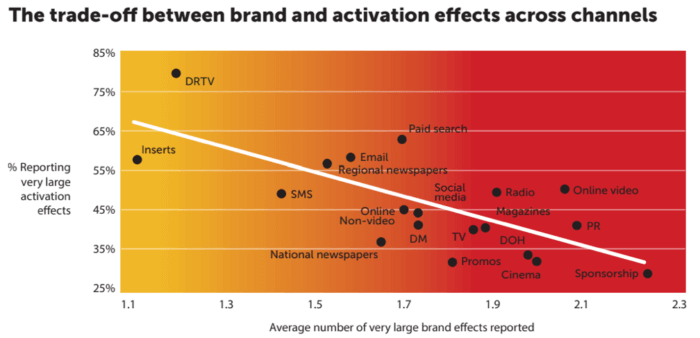
[Source: Les Binet and Peter Field, Media in Focus: Marketing Effectiveness in the Digital Era, IPA]
Within this post, I’d like to set out a handful of steps that any marketer can use as a blueprint for creating an integrated marketing communications plan.
The benefits of integrated marketing communication
Every marketing campaign will be different - from the overarching objective, through to the content, media and call to action. However, as marketers, it’s our responsibility to look beyond our individual silos and look for opportunities to connect the dots and develop campaigns that use different elements that support one another.

It’s worth highlighting some of the benefits of creating a truly IMC plan:
Increase profits
By establishing a unified message across media touchpoints, campaigns are more effective
Drive sales
Stretching messages across different communications enable brands to increase reach and drive positive business results.
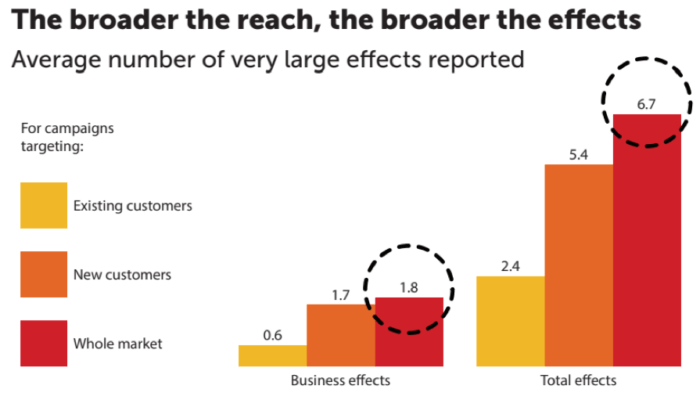
[Source: Les Binet and Peter Field, Media in Focus: Marketing Effectiveness in the Digital Era, IPA]
Stronger credibility
Consistency across channels generates confidence and credibility in what you are communicating as a brand
Drives efficiencies
By eliminating duplication across media type (e.g. imagery, video, graphics) and agencies, brands can generate improved efficiencies in time and cost.
Key consideration for developing an IMC campaign plan
Now that we’ve established some of the benefits of creating an IMC campaign, let’s look at five steps to consider when developing a new marketing campaign:
Set common objective and strategy across teams
From the very outset of any campaign, it’s crucial to have a clear and common set of objectives. If there is any ambiguity around the campaign’s primary objective, it’s unlikely you’ll have a unified team that can collaborate and complement one another.
Download our Free Resource – Integrated marketing megatrends
Our free integrated strategy guide will step you through 10 success factors that are deployed by leading companies to future-proof their business by creating more effective, joined-up media investments and customer journeys.
Access the
One way to set common goals and objectives is to work together to evaluate what you’re ultimately looking to achieve. For example, you may be launching a new product or service, in which case brand awareness and consideration will be your objective. Alternatively, you may want to drive sales from your existing customer base, meaning cross-sale will be your primary objective.
Whatever you’re looking to achieve, consider your current state versus objective. The strategy you develop will be the bridge between these two elements. To make this work, all teams should be fully invested because the process requires insight from everyone involved.
Some key questions and considerations:
- Strategic goals - what are the overarching business, sales and marketing objectives?
- Targets - what does success look like in terms of size of the opportunity, market share, brand awareness or lead generation?
- Timings - over what period of time should objectives, goals and targets be achieved?
- Budget - what is the budget we’re working to? Is there scope to expand and build over time?
Identify a clear audience insight
The one common factor of every successful campaign is a clear and compelling insight. Mark Pollard, a leading strategist and author of Strategy is Your Words:
“Insights are unspoken human truths, truths the subconscious recognizes when it sees them. Often, insights are the arsenal of comedians and poets. A lot of creatives lookup jokes about particular issues as inspiration for their ideas for this reason.
One of the best ways to find them? Start with something that seems obvious and keep asking ‘Why?’ and ‘What if?’”
There are four main areas that make up a marketing problem, which either on their own or in combination with one another, can be the source of a potential insight:
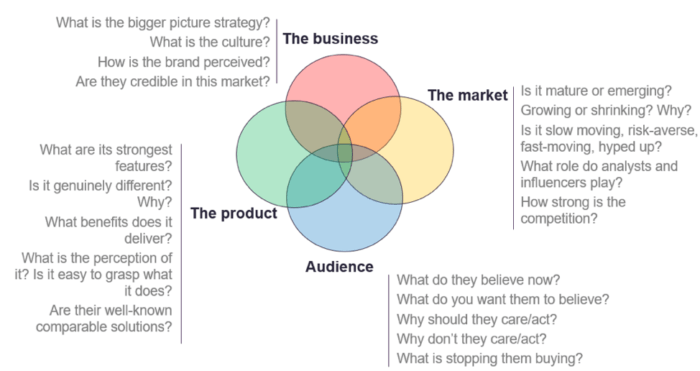
Start with a ‘big idea’
Whilst not always essential, the creation of a ‘big idea’ can act as a very effective centre-point for an integrated marketing campaign. Without a clear, impactful and differentiated concept, there is less opportunity to pierce through the noise and capture the attention of consumers.
The big idea should be an overarching concept that can stretch across all media so that it’s not just limited to one channel. In this context, the big idea can sometimes be referred to as an ‘experience idea’ because it marks the transition from strategy to execution:
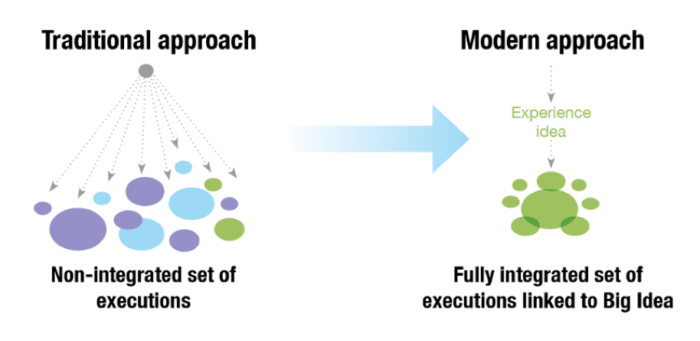
The goal is to develop an idea that is joined up and integrated with all other relevant channels, rather than a series of separate executions that have a tenuous relationship with one another. This approach will put you in a stronger position to engage consumers meaningfully in the places that matter.
Les Binet and Peter Field’s research indicates that ‘fame-driving ‘campaigns give brands a greater opportunity to drive results across a range of measures:
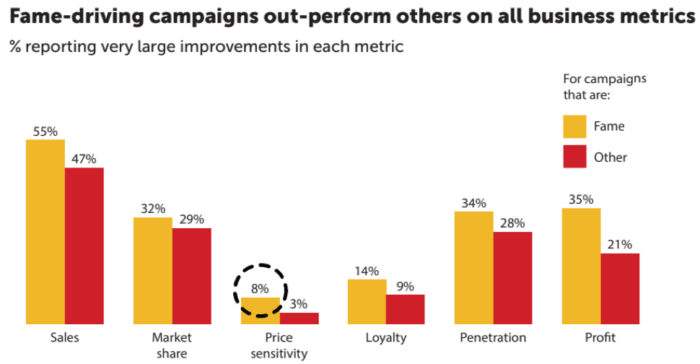
[Source: Les Binet and Peter Field, The Long and the Short of It, IPA]
Drive efficiencies across media channels
The channel planning element of a campaign is where you outline how different media channels will be used to meet your business and marketing objectives based on your budget and audience insight:
- Outline the role of channels - this should provide a top-line/ one-page summary of how your proposed role for channel align with your communications and overarching business objectives. The below shows an example of how this might look like for a brand awareness campaign:
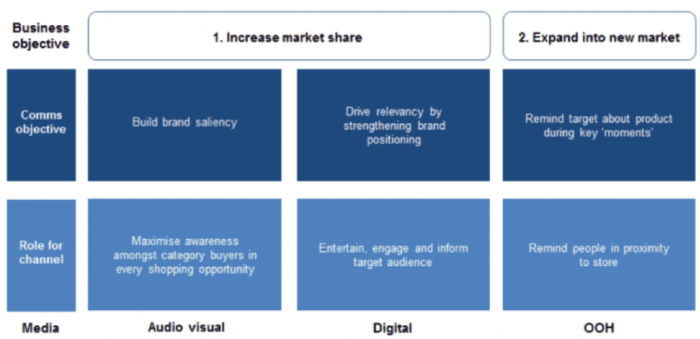
- Media deep-dive - following on from the channel overview, go into detail for each of the main media channels to explain more about how and where these will be used
- Guidelines and best practice - many elements of the media mix will require support and guidance from the lead marketing function. A set of key guidelines will help ensure that at the very least core best practices are followed to minimise mistakes and inefficiencies
Leverage custom data
One area that is not always given the attention it deserves is the use of customer data, an important consideration for driving retention.
Whilst it could be argued that this is something marketers should look at post-campaign (rather than part of the IMC campaign itself), smart use of customer data should always be used to power a campaign and ensure content and media are being used efficiently.
One way to use existing customer data is to interrogate the customer journey for your brand. Although a customer journey is rarely linear, it’s still important to map out the journey from your business’s perspective and the different elements that will impact the customer at each stage:
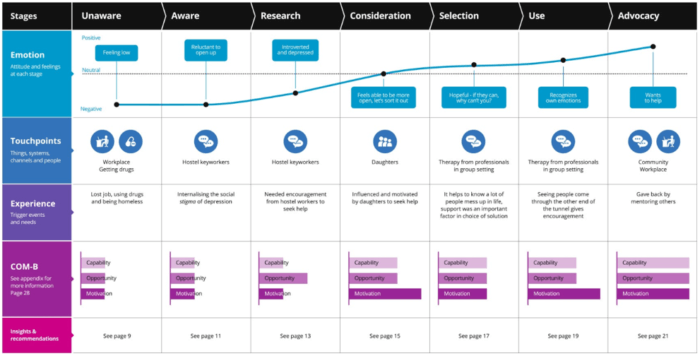
By mapping out the customer journey, you can start providing useful insight:
- Understand how the customer sees themselves at each stage, e.g. our definition of ‘active’ and ‘non-active’ may not align with customers’ perceptions of their relationship with your business
- Identify key communication and content needs at different stages of the journey
- Align contact with different customer types (personas), segments and life stages
Conclusion
Creating an integrated marketing communications campaign requires clear alignment and buy-in from every team involved in the process. By agreeing with an overarching vision and objectives upfront, a campaign team can start acquiring audience insight and develop a creative idea. This will underpin every element within the campaign (from direct mail to TV) and give the brand the best opportunity to reach the target consumers and generate results.













